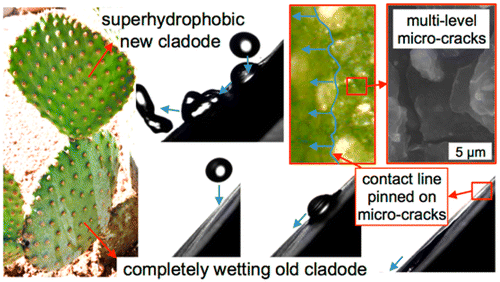Prickly Pear Cacti

Cacti have a special relationship with water since they typically survive in harsh, arid climates. Especially during recent periods of drought in the US, humans' relationships to water must also evolve to treat it like the precious commodity it is.
Biomimetic Designs
Water Filtration and Storage:
Mucilage is the mastermind behind keeping succulents hydrated in harsh, arid climates. It is the substance you find within cacti, and has been proven to be a natural water purifier, if processed correctly. After the 2006 earthquake in Haiti, boiling mucilage in contaminated water was used to help provide clean drinking water for victims. The cactus substance presents an environmentally friendly, surprisingly simple solution to contaminated water. Researchers even believe it could be just as effective as common approaches for filtering oil. The cultivation of this substance and development of the purification method could significantly impact the lives of the one billion people in the world who do not have access to clean, drinkable water.
Mucilage is also special in that it has the ability to rapidly expand and contract according to the water supply available. This has inspired a new type of water collector, specifically from rainwater storage for irrigation.
The design for the water collector has the potential to also condense water from the air, according to a study conducted by students through Arizona State University's Biomimicry Institute. The interaction between the water-repellent, waxy surface of prickly pear cacti, and its age-developing micro-cracks direct water droplets to the most efficient areas of the plant.

The Science Behind Prickly Pear Cacti
Researchers have found that the sugar particles in the mucilage have the ability to filter contaminants such as various chemicals, sediment, and arsenic from polluted water. When mucilage is added to dirty water it binds to the dirt, and particles settle out of the water due to the high molecular weight of the gum-like mucilage.
Mucilage can also bind to and starve bacteria, as well as form a complex with arsenic, a known carcinogen that occurs naturally in the soil or comes from industrial or agricultural pollution. By binding to the natural sugars in mucilage, arsenic sinks through a sand or membrane filter, and is removed from the water all together.
The specific direction of the water droplets is due to the evolving properties of the prickly pear pads, also known as cladodes. New cladodes do, in fact, have the water-repelling, waxy surfaces that most cacti are known for. This means that water droplets typically roll right off the surface of that part. However, older cladodes on the lower parts of prickly pear cacti are a bit different because they are nearly completely wetting. Arizona State University students, in partnership with the Desert Botanical Garden, found the reason behind this water repelling difference was due to multi-level micro-cracks that evolved over time on the surface of the pads.

Spark your Imagination: Explore More Articles
